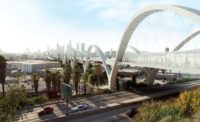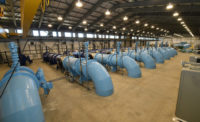It takes serious planning and coordination to keep a large city’s infrastructure up to date. As ENR California’s 2017 Owner of the Year, the city of Los Angeles demonstrates how to achieve this goal by effectively working across various departments and agencies.
One of the largest and most ambitious current endeavors on the city’s slate is Measure M, a half-cent sales tax voters approved in November. Projected to raise $120 billion over 40 years, the program is being led by Los Angeles County Metropolitan Transportation Authority.
“Measure M will significantly transform the city and make a significant improvement in heavy traffic, which is one of the major drawbacks of the region,” says Rick Clarke, Metro chief program management officer.
Metro says the measure is expected to generate an estimated $860 million a year and fund 40 major highway and transit projects in the first 40 years. The main focus of the program budget is capital projects, which include $41.8 billion for transit construction, $20.33 billion for highway construction and $2.39 billion to maintain a state of good repair.
Clarke says a top priority is the $2-billion Purple Line Extension Section 3 in West Los Angeles that will connect rail from Century City to the campus of UCLA and the VA Hospital in Westwood.
“This project is important because it serves the Wilshire Boulevard corridor, one of the busiest arterials in the country,” says Clarke. “And if Los Angeles is fortunate enough to get the Olympics in 2024, we anticipate venues or housing near UCLA campus, so the Purple Line would be a key component.”
Metro intends to award a contract for Section 3 of the nine-mile-long Purple Line in 2018, break ground in early 2019 and complete work in 2024. The 3.9-mile Section 1 is currently under construction, and the joint-venture team of Tutor Perini/O&G won the contract for the 2.6-mile-long Section 2 in January.
Another top Measure M project is the Airport Metro Connector (AMC) 96th Street Transit Station. This $581-million design-bid-build job involves constructing a new transit station next to Los Angeles International Airport (LAX) that will connect to a new automated people mover (APM) being built by the airport to serve LAX passenger terminals.
Designed by Gruen Associates, the AMC is going up “hand-in-hand” with LAX’s APM project, says Clarke. He says the AMC should break ground in 2018 and be finished in 2021, to coincide with the APM completion.
“We are working closely with Metro to make sure there is a smooth transition for the riders on the public transit system to walk over to our platform and come into our central terminal area,” says Cynthia Guidry, deputy executive director in the Planning and Development Group at Los Angeles World Airports.
Like Metro, LAWA is overseeing a major modernization. Guidry says LAX is in the midst of a $14-billion upgrade. “We have something going on in every area of our airport whether it be landside, terminals or airside,” she says, adding that there are about two dozen projects worth approximately $7 billion currently under construction.
As for work focused on the city’s water supply, Los Angeles Bureau of Sanitation (LASAN) is leading the way with about $300 million being invested annually on sanitation infrastructure related projects and roughly 275 construction projects going on across the city.
The agency’s largest project is the visionary One Water LA 2040, an estimated $10-billion to $20-billion, 25-year program to update, integrate and monitor systems for all the water that flows through Los Angeles (ENR 11/7/2016 p. 20). LASAN is heading the project along with the Los Angeles Department of Water and Power (LADWP).
“One Water is an all-encompassing bridge planning effort around the different parts of water,” says Enrique Zaldivar, LA Sanitation executive director and general manager. “The goal is to derive the best and highest value of each part of the water cycle toward a common goal of helping local water supply.”
Besides One Water LA 2040, LADWP is working to conserve rainfall at the 150-acre Tujunga Spreading Grounds in Sun Valley, a few miles north of downtown Los Angeles. This $27-million project involves deepening and widening basins and excavating nearly 2 million cu yd of soil. The agency will add telemetry and improve intake structures to double the facility’s intake capability. The project is scheduled for completion in spring 2019.
“This is the most important project we have going on in terms of local water supply because of its sheer size and in terms of replenishing the groundwater aquifer,” says Rafael Villegas, acting waterworks engineer for LADWP. “This immediate project is part of our overall strategy to improve the capture of rainfall in the region and keep the water from going out into the ocean.”







